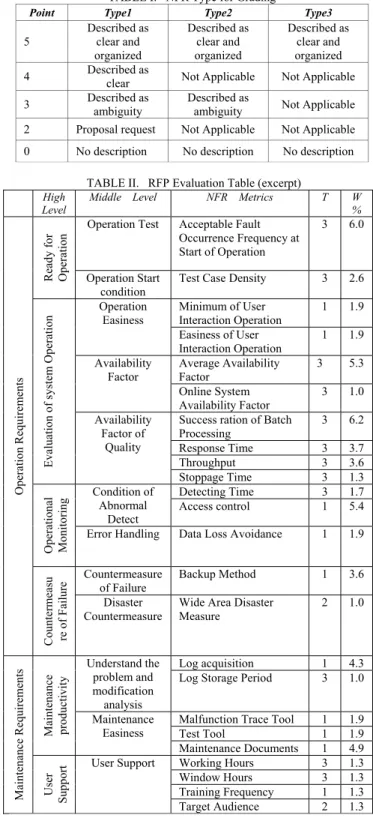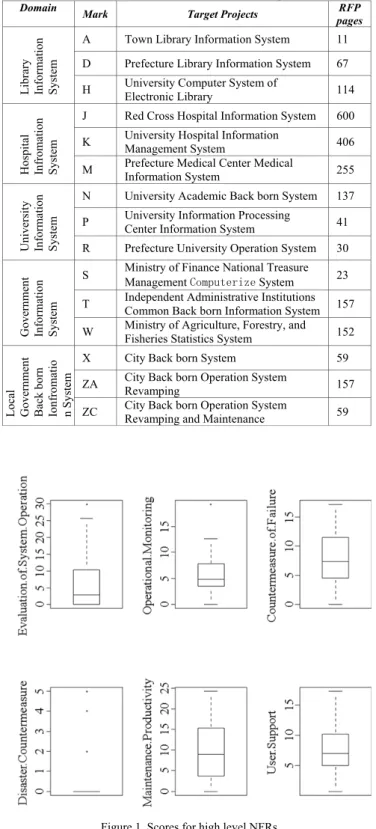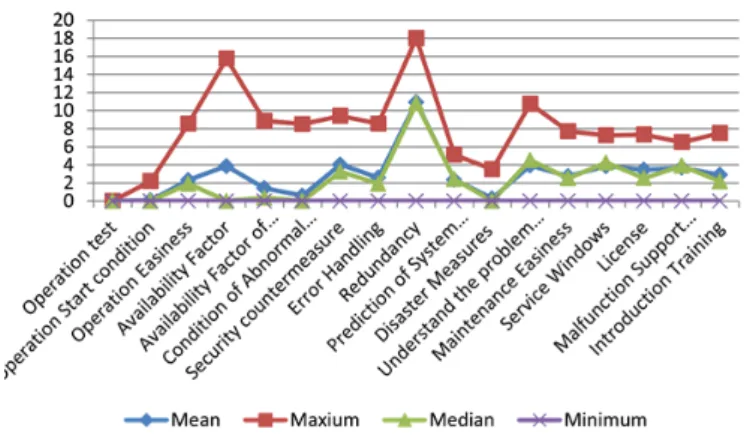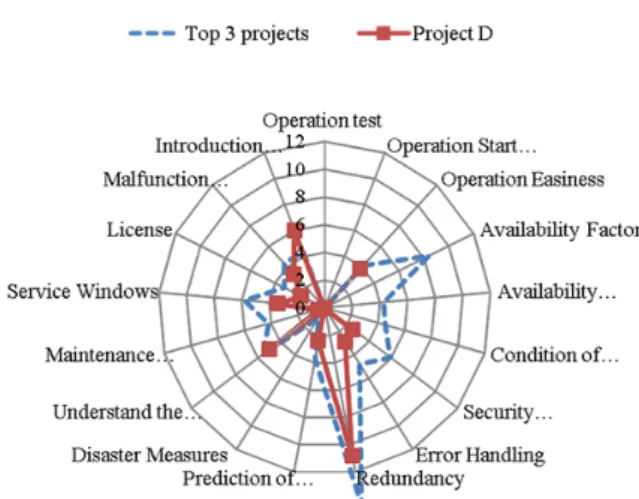Evaluation of Non Functional Requirements in a Request for Proposal (RFP)
全文
(2) Evaluation of Non Functional Requirements in a Request For Proposal (RFP) Yasuhiro Saito. Akito Monden. Graduate School of Information Science Nara Institute of Science and Technology Nara, Japan yasuhiro-s@is.naist.jp. Graduate School of Information Science Nara Institute of Science and Technology Nara, Japan akito-m@is.naist.jp. Kenichi Matsumoto Graduate School of Information Science Nara Institute of Science and Technology Nara, Japan matumoto@is.naist.jp Abstract— In the beginning of a contracted based software development project, the RFP is provided by a software user company and used as an initial system requirements specification to ask software developer companies to propose their technical plans to fulfill the requirements. In this process, it is very important to evaluate the quality of the RFP to make sure that basic user requirements are written enough. Especially, nonfunctional requirements (NFRs) are important since the system architecture greatly depends on the NFRs such as response time and security issues. This paper proposes a simple evaluation model of NFRs included in the RFP, mainly focusing on the user maintenance and operation issues. This model consists of NFR categories, NFR metrics, description level grading and weight to each NFR. As a case study, RFPs of 29 projects were evaluated by the proposed model. As a result, we confirmed that the model could identify poorly-written NFR aspects in the RFP, which need refinement before asking the developer company for a proposal. Keywords-RFP; requirements evaluation;. I.. INTRODUCTION. In contract-based software development projects, a software user company prepares a Request For Proposal (RFP) to ask software developer companies to propose their technical plants to fulfill the requirements written in the RFP. The RFP contains organization’s initial system requirements such as business requirements, system architecture requirements, functional requirements, non-functional requirements, license agreement, bidding qualification of suppliers, contract conditions and so on. However, there is no clear evaluation criteria to make sure that basic user requirements are written enough in the RFP. Indeed, a lot of problems happen due to low quality of the RFP. For example, gap between user’s. intended requirements and developer’s understanding exposes after the user and the developer has signed a contract. In this paper we focus on the comprehensiveness of nonfunctional requirements (NFRs) rather than functional requirements (FRs) written in the RFP. It is because (1) all the commonly-used NFR metrics, such as response time, access control and availability factors, must be comprehensively written in any types of systems, and (2) these NFRs greatly affect the selection of software architecture [2], and changing of architecture is extremely difficult after the development has started; thus, to avoid project failure, comprehensiveness of NFRs in the RFP is extremely important. Moreover, the architecture is often explicitly proposed in the RFP, and the developer company needs to evaluate its validity and/or feasibility based on the NFRs. On the other hand, FRs are more application specific; thus, evaluation of their comprehensiveness is difficult. Also, since the RFP is an initial user-side document, FRs are changeable and not necessarily fully-written in the RFP; thus, we decided not to evaluate the comprehensiveness of FRs. To evaluate the comprehensiveness of NFRs, we focus on the NFR metrics, and evaluate whether they are well written in the RFP or not. To date, more than 200 NFR metrics have been proposed in NFR guidelines [3]. However, these NFR metrics are assumed to apply them in a software development process for project managers. Therefore, many of these NFR metrics are not important for user-side organizations; and, not necessarily fully-written in the RFP. In this paper, we select NFR metrics that need be evaluated from the perspective of user-side organizations. This paper uses a user-side organization survey [14] for the purpose of prioritizing NFR metrics. As a result, NFR metrics related to user operation and.
(3) maintenance process (especially, related to service level agreement) are mainly extracted. To evaluate how well requirements for each NFR metric (such as response time) are written in the RFP, this paper defines a 5-level grading of NFR metrics. Furthermore, this paper proposes a categorization of NFRs of the operation and maintenance process based on software process guidelines[15] [16], then maps NFR categories to NFR metrics. We also add weights to NFR metrics according to the importance of metrics to user companies. As a result, our NFR evaluation of model consists of NFR categories, NFR metrics, description level grading and weight to each NFR. To conduct a case study of applying our NFR evaluation model, we collected RFPs of 29 projects from the WWW including Library information system, Hospital management information system, University Information System, Government information system and Local government backbone information system. In the case study, baseline grades for RFP evaluation were derived based on top three (highest score) projects. We also provide radar chart with the baseline grades to visualize the quantitative evaluate of RFPs. II.. RELATED WORK. A Evaluation of RFP Several studies have focused on evaluating RFPs from the point of view of coverage of user’s requests in an early stage of development. To avoid the ambiguity of user requirements and make sure all stakeholders are involved, the QFD (Quality Function Deployment) method[4] has been proposed. Also, a tool to estimate the percentage of quality-related aspects in the requirements document using natural language processing has been proposed [5]. These studies focus on techniques for reducing the ambiguity of the RFP to evaluate the quality of functional requirements (FRs). On the other hand, we focus on the evaluation of NFRs, which we consider them more important before signing a contract of development. B Evaluation of NFR Several studies have done to conduct software requirement analysis and/or software modeling focusing on NFRs [6][7][8][9][10] although these studies does not target the RFP. In [8], the research focuses on prioritization of requirements based on their impact on the architecture configuration process, and add weights on requirements based on the relative relation between the enabling factors and impending force [8]. In [6], using fifteen projects as a training dataset, they proposed a classification method of NFR types. While these studies evaluates some aspects of NFRs with respect to software architecture design or others, we focus on the user companies’ operation and maintenance processes to evaluate NFRs because they directly relate to the cost required after software release. C Guidelines for Software User companies Several guideless for software user companies have been published. These include articles for (1) requirement analysis and/or definition, (2) metrics for software requirements, and (3) contract between the user company and the developer company.. Regarding guidelines for software requirements, “a user view guideline” [11] is provided by the Information-Promotion Agency, Japan. This guideline is related to FRs to share the explicit image of a software system between user side and developer side. As for NFRs, “a guideline for defining nonfunctional requirements specification” [3] was published by Japan Users Association of Information Systems (JUAS). This guideline refers to software quality characteristics of ISO/IEC09126, and provides wide variety of more than 200 NFR metrics that can be used throughout the software lifecycle. We refer to [3] and select NFR metrics that need be evaluated from the perspective of user-side organizations. Regarding guidelines for software requirements metrics, “a survey report on software development management criteria” [15] published by JUAS includes survey of necessary metric including software operation and maintenance. However, since too many metrics are provided, we need to select useful metrics that can be included in a RFP from the point of view of user companies. Also, METI, Japan has conducted a survey called “software metrics advanced projects” [14]. This survey provides a ranking of necessary metrics based on interviews to many user companies. We take advantage of this ranking to select useful NFR metrics in the RFP. Regarding guidelines for contract between the user company and the developer company, “a procedure and a vital point for a IT systems contract to avoid troubles in system integration” [12] is published to avoid ambiguous contract. Also, as a reference contract model for the government-related IT systems acquisition, “Technical Reference Model (TRM) for IT systems acquisition” [13] was published by the Information-technology Promotion Agency (IPA) and Ministry of Economy, Trade and Industry (METI), Japan. This guideline intended to be used by an evaluator of technical requirements of IT systems. Some of NFR metrics are described in the guidelines, and these are important since contract issues should be included in the RFP. III.. CONSTRUCTION OF NFR EVALUATION MODEL. Below describes our procedure to construct a NFR evaluation model for the purpose of evaluation of RFPs. [Step 1.] Selection of NFR metrics We first need to prepare a comprehensive list of NFR metrics that might be included in a RFP. Then, we select NFR metrics that are useful to user companies, and possible to be included in a RFP. [Step 2.] Categorization and abstraction of NFRs The categorization and abstraction helps users to understand how each NFR relate to each other. [Step 3.] Definition of 5-level grading for evaluation To evaluate how well requirements for each NFR metric are written in the RFP, this paper defines a 5-level grading of NFR metrics. [Step 4.] Building a scoring system for different abstraction levels. Below describes details of these steps..
(4) Excluding NFR metrics managed in the software design phase. . Excluding NFR metrics that are difficult to define in the requirement analysis phase. . Excluding NFR metrics that should be internally managed and/or evaluated by the user company. . Excluding NFR metrics that should be managed as hardware equipment requirements.. . Including NFR metrics whose number of answers “it is important after system testing” is larger than three in [14]. Type3. Described as clear and organized. Described as clear and organized. Not Applicable. Not Applicable. Described as ambiguity. Not Applicable. Not Applicable. Not Applicable. 0. No description. No description. No description. TABLE II. RFP Evaluation Table (excerpt). Ready for Operation. High Level. Maintenance Requirements. Countermeasu re of Failure. B Step 2 Categorization and structured NFRs We classified NFRs into three abstract levels: “High”, “Middle” and “Low” based on [15][16]. Then, NFR metrics are mapped to low level NFR categories.. D Step 4 Building a scoring system for different abstraction levels To compute a score for each NFR abstraction level (high, middle and low), we set weights to NFR metrics because each NFR metric has different importance. The numbers of “yes”. Type2. Described as clear and organized Described as clear Described as ambiguity Proposal request. As a result, we selected 38 metrics.. C Step 3 Definition of 5-level grading for evaluation We classified NFR metrics into three types (Table I.) As shown in Table I, 5-level grading was defined for Type 1 metrics, 3-level grading for Type 2, and 2-level grading for Type 3. Type 1 NFR metrics are qualitative and not well defined; therefore, 5-level grading was applied. Type 2 NFR metrics are also qualitative and still containing a little ambiguity in their definitions; therefore, 3-level grading was applied. Type 3 NFR metrics are quantitative and more well defined; therefore, 2-level grading was applied. For example, the metric “access control” is Type 1 since there are several ways to describe access control issues. On the other hand, “response time” is Type 3 since its definition is clear.. Type1. 2. Evaluation of system Operation. . 3. Operational Monitoring. Including NFR metrics whose number of answers “actually using / want to use” is larger in [14]. 4. Maintenance productivity. . 5. User Support. Next, to select NFR metrics, we refer to the survey report [14] that provides a ranking of necessary metrics based on the questionnaire to many user companies. The survey report was used to select NFR metrics that are (1) useful to user companies, (2) related to user operation and maintenance, and (3) available in the require definition phase. Operational and maintenance requirements should be described in the RFP because these greatly affects the user organization’s cost after receiving a finished product from the developer organization. The followings are details of criteria for selection of NFR metrics.. TABLE I. NFR Type for Grading Point. Operation Requirements. A Step 1 Selection of NFR metrics At first, we prepare a comprehensive list of NFR metrics that might be included in a RFP. Since a guideline [3] and a survey report [14] provide wide variety of (more than 200) NFR metrics comprehensively, we use NFR metrics in these articles as a start point.. Middle Level. NFR. Metrics. T. W %. Operation Test. Acceptable Fault Occurrence Frequency at Start of Operation. 3. 6.0. Operation Start condition Operation Easiness. Test Case Density. 3. 2.6. Minimum of User Interaction Operation Easiness of User Interaction Operation Average Availability Factor Online System Availability Factor Success ration of Batch Processing Response Time Throughput Stoppage Time Detecting Time Access control. 1. 1.9. 1. 1.9. Availability Factor Availability Factor of Quality. Condition of Abnormal Detect Error Handling Countermeasure of Failure Disaster Countermeasure. Understand the problem and modification analysis Maintenance Easiness User Support. 3. 5.3. 3. 1.0. 3. 6.2. 3 3 3 3 1. 3.7 3.6 1.3 1.7 5.4. Data Loss Avoidance. 1. 1.9. Backup Method. 1. 3.6. Wide Area Disaster Measure. 2. 1.0. Log acquisition Log Storage Period. 1 3. 4.3 1.0. Malfunction Trace Tool Test Tool Maintenance Documents Working Hours Window Hours Training Frequency Target Audience. 1 1 1 3 3 1 2. 1.9 1.9 4.9 1.3 1.3 1.3 1.3. answers to a question “it is important to user companies?” in [14] was used as a weight for each NFR metric since a high number means more important for user organizations. As a result, we constructed a “RFP Evaluation Table” (Table II). In Table II, “T” refers to NFR Type for grading, and “W” refers to weight for each NFR metric. The following equations show how to compute evaluation scores for NFR metrics, middle level NFRs and high level.
(5) NFRs. Project k’s evaluation score for i-th NFR metric mi is defined as follows: scorek (mi) = 5-grade evaluation of mi * weight of mi. TABLE III. RFPs for Evaluation (excerpt). Library Information System. Domain. Hospital Infromation System. Then, the score for i-th middle level NFR Mi is as follows: / |Mi| scorek(Mi) = ∑ ∈ where m∈Mi is a NFR metric belongs to a middle level NFR Mi, and |Mi| is the number of NFR metrics belong to Mi. Similarly, the score for i-th high level Hi is as follows: scorek(Hi) = ∑ ∈ / |Hi|. Government Information System. CASE STUDY OF RFP EVALUATION. RFPs of 29 Japanese software projects were used in this case study. Many of Japanese RFPs that have been published on the Web were assumed to adoption of the commercial software package system available. The collected Japanese RFPs were classified into five domains (Library information systems, Hospital management information systems, University Information Systems, Government information systems and Local government backbone information systems), and the number of projects in each domain were selected approximately same as possible. Overview of the target RFPs are shown in Table III.. Local Government Back born Ionfromatio n System. IV.. University Information System. Next, the average score of i-th middle (and high) level NFR in a given system domain D is computed as follows: / |D| scoreD(Mi) = ∑ ∈ scoreD(Hi) = ∑ ∈ / |D| where j∈D is a project belongs to D.. Mark. Target Projects. RFP pages. A. Town Library Information System. 11. D. Prefecture Library Information System. 67. H. University Computer System of Electronic Library. 114. J. Red Cross Hospital Information System. 600. K M. University Hospital Information Management System Prefecture Medical Center Medical Information System. 406 255. N. University Academic Back born System. 137. P. University Information Processing Center Information System. 41. R. Prefecture University Operation System. 30. S T W X ZA ZC. Ministry of Finance National Treasure Management Computerize System Independent Administrative Institutions Common Back born Information System Ministry of Agriculture, Forestry, and Fisheries Statistics System City Back born System City Back born Operation System Revamping City Back born Operation System Revamping and Maintenance. 23 157 152 59 157 59. A Analysis on the number of pages of RFPs The average number of (total) pages of 29 RFPs was 104. Also, the average number of NFR pages was 33. Furthermore, the average number of NFR pages related to the operational and maintenance requirements (that is, our evaluation target) was 17. In most RFPs, there was a moderate correlation between the number of total pages and “operational and maintenance NFR” pages. However, in some projects (such as K, M, and E), 80% of total pages were related to operational and maintenance NFRs. On the other hand, in some projects (such as J and P), this percentage was lower than 20. B. Evaluation result of all projects Scores of high level NFRs are shown in Figure 1. From the figure, the following characteristics were observed. •. “Countermeasure of Failure” and Productivity” had the highest scores.. •. On the other hand, “Disaster Countermeasure” was zero except 3 projects.. •. Scores of middle level NFRs are shown in Figure 2. From the figure, the following characteristics were observed.. Almost all project had zero score for “ Availability Factor” and “ Availability Factor for Quality”.. •. "Redundancy" had the extremely high score compared with other middle level NFRs.. •. "Service windows" and "Malfunction support Logistics" had relatively high score among middle level NFRs.. •. “Maintenance Figure 1. Scores for high level NFRs.. “Ready for Operation” had zero score for all projects.
(6) Figure 2. Scores for middle level NFRs.. C Evaluation result for individual domain Figure 3 and 4 shows avarage scores in each domain. The ranking from the highest score domain to lower score domains were "Hospital Information System", "Local Government Back Born Information System", "Government Information System", "University Information System" and "Library Information System". The top two domain often require to use COTS in development, and in such domains, domain specific system development guidelines are already provided. For example, in Hospital Information System domain, "Safety Guidelines of Medical Information: Ministry of Health, Labor and Welfare" is provided. Also in Local Government Back Born Information System domain, "Regional information platform: Information systems and local institutions" is provided. Because of these domain specific guidelines, they could achieve high RFP evaluation score compared to other domains. In each domain, the following NFR metrics are emphasized. • Library Information System; Security • Hospital Information System; Goal Availability factor • University Information System; Service Windows • Government Information system; Goal Availability factor • Local government Back Born Information System; Goal Availability factor D Comparison with top 3 projects Since achievement of maximum scores for all NFR metrics is very difficult, here we compare with top 3 projects’ average score. Figures 5 and 6 show a case study of project D, which is had a median score in total. • In high level NFRs (Figure 5), “Fault Countermeasure” and "Operations and User Support" had a high evaluation score but "System Operation" and "Maintenance Productivity" had a low evaluation score. • In middle level NFRs (Figure 6), "Redundancy", "Malfunction Support Logistics" and "Introduction Education" were a relatively high evaluation score but. Figure 3. Average scores for high level NFRs in each domain.. Figure 4. Avarage scores for middle level NFRs in each domain.. "Availability Factor", "Availability Factor of Quality" and "Security Countermeasure" had a relatively low evaluation score. V.. SUMMARY AND FUTURE WORK. This paper proposed an evaluation model of NFRs included in the RFP, mainly focusing on the user maintenance and operation issues. The model consists of NFR categories, NFR metrics, description level grading and weight to each NFR. As a case study, RFPs of 29 projects were evaluated by the proposed model. As a result, we confirmed that the model could identify poorly-written NFR aspects in the RFP, which need refinement before asking the developer company for a proposal..
(7) [1] [2]. [3]. [4]. Figure 5. Comparison of project D and top 3 projects (high level NFRs). [5]. [6]. [7]. [8]. [9] [10]. [11] Figure 6. Comparison of project D and top 3 projects (middle level NFRs). In this paper, 29 RFPs used were all Japanese software projects. As a future work, we plan to evaluate RFPs of different countries to increase the reliability of our results and to improve our evaluation model. ACKNOWLEDGMENT A part of this work was conducted under Japan Society for the Promotion of Science, Grant-in-Aid for Scientific Research (C) (22500028).. [12]. [13]. [14]. [15] [16]. Polter-RothBud, (Yoko Watanabe). “RFP Introduction First reason of Request for proposal”, Nikkei BP Soft Press, 2004. Rick KazmanKlein, Mario Barbacci, Tom Longstaff, Howard Lipson, JeromyCarriereJaneMark, “The Architecture Tradeoff Analysis Method” TECHNICAL REPORT CMU/SEI-98-TR-008ESC-TR-98-008, 1998. Ministry of Economy, Trade and Industry , Information Processing Promotion Division, NTT Data Institute of Management, Japan Users Association of Information Systems “A guideline for defining nonfunctional requirements specification”, 2008. Kou Liu , Shin-ichiro Yokoyama, Nobuaki Ishii, Tomoyuki Tamura, Ichirou Ushijima, Naoto Nakamura, Hiroaki Sakamaki, Shun Kato, Yasunobu Kino, Kazuo Kawai, Yumi Kusakabe, “Proposal of RFP Model and Utilization Method based on Stakeholder Value -Report of the Study Group on Applying QFD to Project Planning-“, conference of the Society of Project Management Spring 2008 fiscal year, 2008. Tomonori Sato , Shunichi Suzuki, Naoyuki Kitazawa, Akira Osada, Haruhiko Kiya, Kenji Kaijiri, “Design of a tool for measuring quality ratio in a software requirements specification” (2008 THE INSTUTE OF ELECTRONICS, TECHINICAL REPORT OF IEICE). Jane Cleland-HuangXuchangZou, Peter Solc, Raffaellasettimi, “The Detection and Classification of Non-Functional Requirements with application to Early Aspects”, 14th IEEE International Requirements Engineering Conference(RE’06), 2006. Matinee Kiewakanya Pornsiri Muenchaisri, “Measuring Maintainability th in Early Phase using Aesthetic Metrics”, 4 World Scientific and Engineering Academy and Society, 2005. Matthias Galster Armin Eberlein, “Facilitating Software Architecting by Ranking Requirements” 18th IEEE International Conference and Workshops on Engineering of Computer-based system, 2011. Jennitta Andrea, “An Agile Request for Proposal(RFP)”, Process. Prfoceedings of Agile Development Confrrence(ADC’03) IEEE, 2003. Vanitha SugumaranDrakeJanet, “Quantifying Quality of Non-Functional Quality Attributes Using Customer Survey Metrics”, Proceedings of the Fifth Workshop on Software Assessment22, 2006. Software Engineering Center, Information-technology Promotion Agency, “outsourcer view guidelines. Ver1.0 outline”, 2008. Naoki Bando , Takashi Hirano, Takao Iwai, “A procedure and a vital point for a IT systems contract to avoid troubles in system integration”, Nikkei BP. 2008. Ministry of Economy, Trade and Industry Commerce and Information Policy Bureau, Information-Technology Promotion Agency, “Technical Reference Model (TRM) for IT systems acquisition 2010 edition”, 2011. http://www.meti.go.jp/policy/it_policy/tyoutatu/TRM22.pdf Ministry of Economy, Trade and Industry, Mitsubishi Research Institute Inc, “ Product Quality Metrics WG Activities in 2010 Software Metrics Advancement Project” , 2010. Japan Users Association of Information Systems, “A survey report on software development management criteria”, 2011. Information-Technology Promotion Agency Software Engineering Center, “Common frame 2007”, Ohm Inc. 2007..
(8)
図




関連したドキュメント
For instance, what are appropriate techniques that fit choice models, especially those applied in an RM network environment; can new robust approaches reduce the number of
Cathy Macharis, Department of Mathematics, Operational Research, Statistics and Information for Systems (MOSI), Transport and Logistics Research Group, Management School,
Next we shall prove Lemma 3.. Then G=F' follows from Proposition 1. This completes the proof of Lemma 3. Let us consider the exact sequence.. r\
Infinite systems of stochastic differential equations for randomly perturbed particle systems in with pairwise interacting are considered.. For gradient systems these equations are
We study parallel algorithms for addition of numbers having finite representation in a positional numeration system defined by a base β in C and a finite digit set A of
Keywords and phrases: super-Brownian motion, interacting branching particle system, collision local time, competing species, measure-valued diffusion.. AMS Subject
The advection-diffusion equation approximation to the dispersion in the pipe has generated a considera- bly more ill-posed inverse problem than the corre- sponding
We review integrals of the systems invariant under the corresponding Weyl group and as their limits we construct enough integrals of the non-invariant systems, which include